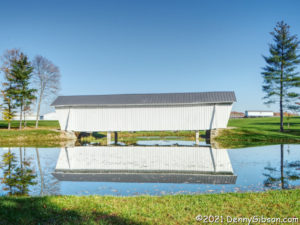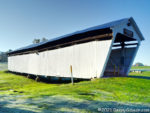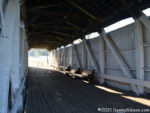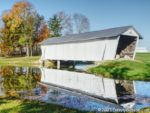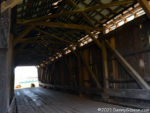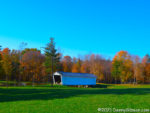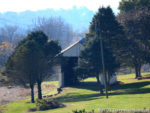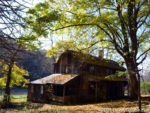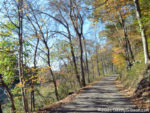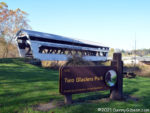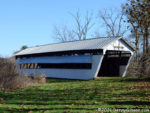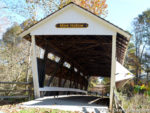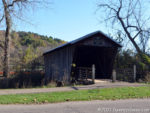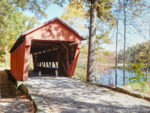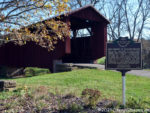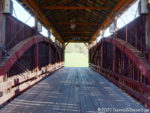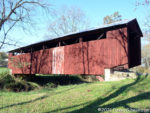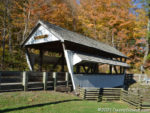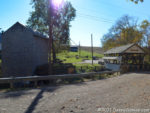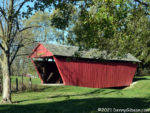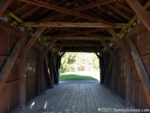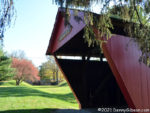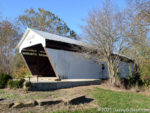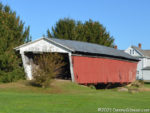When I took in Preble County Covered Bridges a couple of weeks ago, there was actually another Ohio county in the running for the “honor”. Fairfield County rivals Ashtabula County for the number of covered bridges and is much closer. Of course, Preble County is closer still and I decided to save Fairfield for a day when there was a chance that the trees would be more colorful. Friday was that day but, even though there were some mighty colorful trees here and there, I never did find that picturesque little bridge framed with orange and gold that I envisioned.
Unlike the rather spontaneous Preble County jaunt, I actually did some advance planning for this outing. I started at the Charles Holliday Bridge (#1) on the Millersport Lions Club Sweet Corn Festival grounds. This happens to be bridge #1 in the Fairfield County Covered Bridge Trail Guide but I did not visit the bridges in the sequence they are numbered in the guide. I started with the bridge farthest from my home then hit the rest in a very crude horseshoe pattern. The numbers following each bridge name are from the guide, however.
My second stop was at the R.F. Baker Bridge (#12) behind the Fairfield Union School. It’s not visible from the parking lot but directions from a friendly student got me there. This is the closest thing I found to that bridge framed by autumn colors in my mind’s eye. You have probably figured out that this is the bridge in the opening photograph and you may have also figured out that it is my favorite.
The John Raab Bridge (#8) is on private property and some distance from the road. I think it was possible that I could have gotten permission from the owner for a closer look but I just settled for a shot from the road with a longer lens mounted. That lens was still on the camera when I started to pull away and spotted a fox scurrying across the open field.
I made my Preble County bridge post a member of the My Cabbodles series but not this one. The reason is that two of Fairfield County’s listed bridges are inaccessible inside a park that is temporarily closed. I believe the address I had matches that of the pictured house although I saw nothing that indicated a park. Nonetheless, I think Mae Hummel Bridge (#9) and Shade Bridge (#14) are around here somewhere.
Only four of Fairfield County’s seventeen covered bridges remain at their original locations and three of them are pictured here. At first glance, I thought all three might have had the same builder but that’s not so. The Johnston Bridge (#7) was built by Augustus Borneman while the Mink Hollow Bridge (#11) was built by Jacob Brandt. No builder is identified for the Hanaway Bridge (#3).
Both of these bridges have been moved, but they still cross water and they are still in use although traffic is now pedestrian-only. The George Hutchins Bridge (#2) serves foot traffic in Alley Park while the McCleery Bridge (#10) helps folk cross Fetters Run on the Lancaster Bike Path.
The John Bright #2 Bridge (#6) has also been moved, still crosses water, and serves pedestrians. Like the McCleery Bridge, it is on Fetters Run and the Lancaster Bike Path. Its description states that it is the “gateway to Lancaster Festival concerts at Ohio University”. I’m guessing those concerts take place in the large open field beyond the bridge.
Rock Mill Bridge (#13) is the fourth covered bridge in Fairfield County surviving in its original location. The mill after which it is named also survives right next to it. The Fairfield County Covered Bridge Trail Guide claims that “At one time, every U.S. Embassy in the world displayed a photo of Rock Mill Bridge.” I haven’t yet found anything online to explain or confirm that so I’ve sent a query to the Fairfield County Ohio Visitors and Convention Bureau and will update this with any information I receive.
Here’s a bridge that has been relocated to a spot that once had water but no longer does. The Hartman #2 Bridge (#4) now sits astride what was once the Ohio & Erie Canal between Lock 11 South and Lock 12 South. The stone walls of Lock 12 South can be seen beyond the bridge in the third picture.
The Shryer Bridge (#15) is on private property with no obvious place to pull over so I really did grab a driveby shot of it. Inside Sycamore Creek Park, the relocated Zeller-Smith (#17) serves as the entrance to an arboretum. The Stemen House Bridge (#16) was relocated and shortened from 72 to 36 feet in length. Damaged and decayed parts were discarded during the move but the half that was saved was so good that now stands as the only public covered bridge in the county open to vehicles.
I had to add the word “public” to the previous sentence since this privately owned bridge is open to vehicles driven by the owner or friends. The Hizey Bridge (#5) once crossed Poplar Creek but has been moved to form part of an impressive private driveway.
If that park is ever opened and those two other bridges become accessible, I suppose I might go see them. Then I can republish these pictures as a caboodle. But the truth is that I was a little disappointed in the covered bridges of Fairfield County and it had little to do with the two hidden bridges or not finding the perfect wall of orange and gold leaves. It had to do with there being only two drivable bridges (one if you’re me) in the lot and so many that weren’t actually bridges at all anymore. By that, I mean those sitting in fields that don’t cross over anything that needs crossing. By contrast, six of the eight Preble County bridges were drivable and all nine of the Ashtabula County bridges I visited in 2019 were drivable. There are ten other covered bridges in Ashtabula County that I have not visited and about which I’ll make no claims.
On the other hand, even those that were sitting in someone’s yard, crossing nothing and accessible by no one, had escaped destruction. I’m reminded of something Tod Swormstedt of the American Sign Museum often says. According to Tod, the best way to preserve a sign is in its original setting doing what it was designed to do. Preserving them in museums and private collections isn’t nearly as good but is better than the scrap heap. I guess that applies to bridges, too. I prefer my historic bridges in the wild carrying vehicles over some body of water just like they were designed to do. Parks and private settings aren’t nearly as good — but they’re better than the scrap heap.

